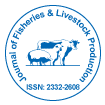Underwater Acoustics for Environmental and Resource Assessment
Received: 01-Mar-2025 / Manuscript No. jflp-25-164391 / Editor assigned: 03-Mar-2025 / PreQC No. jflp-25-164391 / Reviewed: 17-Mar-2025 / QC No. jflp-25-164391 / Revised: 21-Mar-2025 / Manuscript No. jflp-25-164391 / Published Date: 28-Mar-2025
Keywords
Underwater acoustics; Marine environment; Resource assessment; Sonar systems; Acoustic monitoring; Oceanography
Introduction
The exploration and understanding of the marine environment are pivotal to managing and conserving Earth's oceans. As much of the ocean remains unexplored due to its vastness and inaccessibility, innovative tools and technologies are required to bridge the knowledge gap [1]. One such powerful tool is underwater acoustics. Often referred to as hydroacoustics, underwater acoustics involves the generation, transmission, and reception of sound waves in water to study and assess marine environments and resources. From tracking fish populations to monitoring environmental health, underwater acoustics has become indispensable in both scientific research and commercial operations. This article explores the role of underwater acoustics in environmental and resource assessment, providing insights into its principles, applications, and potential for sustainable ocean use [2].
Brief Description
Underwater acoustics is based on the principles of sound propagation in water, a medium through which sound travels much more efficiently than light or electromagnetic waves [3]. It is widely applied in marine studies due to its capability to penetrate the ocean's depths and gather information about underwater features, organisms, and activities [4]. There are two primary types of acoustic methods: active acoustics, which involve emitting sound waves and measuring their reflection, and passive acoustics, which involve listening to natural or anthropogenic sounds in the marine environment. These methods have become essential for assessing marine biodiversity, mapping seafloors, detecting underwater hazards, and evaluating the impact of human activities on marine life [5].
Discussion
Underwater acoustics has become an indispensable tool in the assessment of marine environments and the exploration of underwater resources. Acoustic technologies, including sonar systems, echo sounders, and passive listening arrays, enable researchers and industry professionals to map the seafloor, detect subsea structures, and monitor marine life with remarkable precision [6]. In environmental assessments, acoustic sensors help track biodiversity, monitor marine mammal presence, and detect changes in oceanographic parameters such as temperature, salinity, and currents often in real time and with minimal ecological disruption [7]. These capabilities are particularly crucial in sensitive habitats or protected zones, where traditional intrusive methods are not feasible. In the context of resource assessment, such as offshore oil and gas exploration or seabed mining, acoustics aid in identifying geological formations, gas seeps, and sediment composition [8]. The use of multibeam sonar and sub-bottom profilers allows for detailed 3D imaging of subsurface structures, which informs safe and sustainable development decisions [9]. However, concerns remain regarding the potential impacts of anthropogenic sound on marine fauna, especially species that rely on echolocation. As such, there is a growing push toward developing low-impact acoustic technologies and implementing best practices that balance exploration with conservation. Overall, underwater acoustics stands at the intersection of innovation and environmental stewardship, offering a non-invasive and scalable approach to understanding and managing the world beneath the waves [10].
Conclusion
Underwater acoustics has revolutionized the way we explore, monitor, and manage the marine environment. By harnessing sound to overcome the challenges of underwater observation, scientists and resource managers gain invaluable insights into ocean dynamics, biodiversity, and resources. From fish stock assessment and habitat mapping to monitoring environmental impacts and supporting conservation policies, acoustic technologies offer versatile and non-invasive solutions for sustainable ocean stewardship. As the world seeks to balance economic development with ecological preservation, the continued advancement and responsible application of underwater acoustics will be crucial. Promoting collaboration, innovation, and accessibility in acoustic science will ensure that we can protect and sustainably utilize the invaluable resources of the ocean for generations to come.
References
- Surtida AP (2000) Middlemen: the most maligned players in the fish distribution channel.
- Rajeev M, Nagendran P (2019)Should They Avoid the Middlemen? an Analysis of Fish Processing Firms in India. Institute for Social and Economic Change.
- Bjorndal T, Fernandez-Polanco J, Lappo A, Lem A (2014) Consumer trends and prefences in the demand for food. SNF Working Paper 17/14.
- Petetin L (2020) The COVID-19 crisis: an opportunity to integrate food democracy into post-pandemic food systems.Euro J Risk Reg11: 326-336.
- Hamilton ND (2011) Moving toward food democracy: Better food, new farmers, and the myth of feeding the world.Drake J Agric L16: 117.
- Aday S, Aday MS (2020) Impact of COVID-19 on the food supply chain.Food Quality and Safety4: 167-180.
- BBC (2020) Coronavirus: How can society thrive post-pandemic?
- DeBroff S (2020) How COVID-19 Has Impacted Consumer Food Habits.Retrieved July 10: 2020.
- Galanakis CM (2020) The food systems in the era of the coronavirus (COVID-19) pandemic crisis.Foods9: 523.
- Rodriguez- Perez C, Molina-Montes E, Verardo V, Artacho R, García-Villanova B, et al. (2020) Changes in dietary behaviours during the COVID-19 outbreak confinement in the Spanish COVIDiet study.Nutrients12: 1730.
Google Scholar, Crossref, Indexed at
Google Scholar, Crossref, Indexed at
Citation: Wiley Z (2025) Underwater Acoustics for Environmental and Resource Assessment. J Fisheries Livest Prod 13: 632.
Copyright: © 2025 Wiley Z. This is an open-access article distributed under the terms of the Creative Commons Attribution License, which permits unrestricted use, distribution, and reproduction in any medium, provided the original author and source are credited.
Select your language of interest to view the total content in your interested language
Share This Article
Recommended Journals
Open Access Journals
Article Usage
- Total views: 705
- [From(publication date): 0-0 - Nov 10, 2025]
- Breakdown by view type
- HTML page views: 579
- PDF downloads: 126
